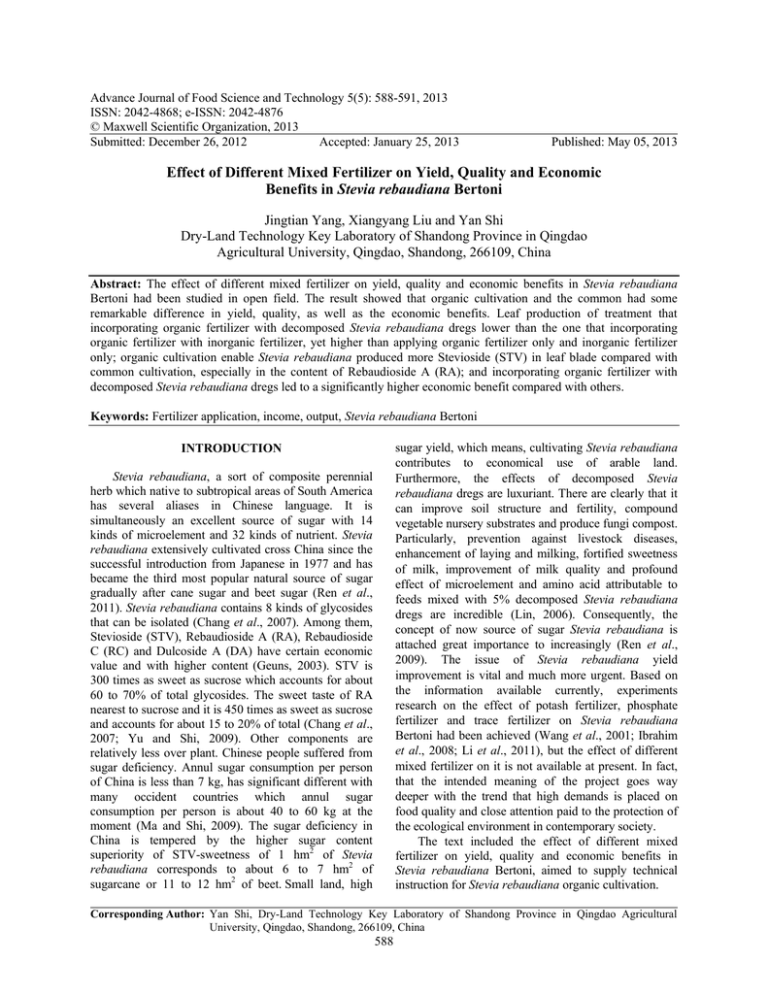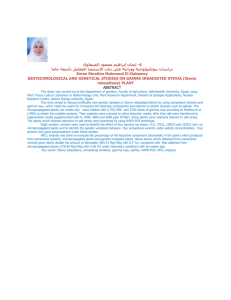Advance Journal of Food Science and Technology 5(5): 588-591, 2013
advertisement

Advance Journal of Food Science and Technology 5(5): 588-591, 2013 ISSN: 2042-4868; e-ISSN: 2042-4876 © Maxwell Scientific Organization, 2013 Submitted: December 26, 2012 Accepted: January 25, 2013 Published: May 05, 2013 Effect of Different Mixed Fertilizer on Yield, Quality and Economic Benefits in Stevia rebaudiana Bertoni Jingtian Yang, Xiangyang Liu and Yan Shi Dry-Land Technology Key Laboratory of Shandong Province in Qingdao Agricultural University, Qingdao, Shandong, 266109, China Abstract: The effect of different mixed fertilizer on yield, quality and economic benefits in Stevia rebaudiana Bertoni had been studied in open field. The result showed that organic cultivation and the common had some remarkable difference in yield, quality, as well as the economic benefits. Leaf production of treatment that incorporating organic fertilizer with decomposed Stevia rebaudiana dregs lower than the one that incorporating organic fertilizer with inorganic fertilizer, yet higher than applying organic fertilizer only and inorganic fertilizer only; organic cultivation enable Stevia rebaudiana produced more Stevioside (STV) in leaf blade compared with common cultivation, especially in the content of Rebaudioside A (RA); and incorporating organic fertilizer with decomposed Stevia rebaudiana dregs led to a significantly higher economic benefit compared with others. Keywords: Fertilizer application, income, output, Stevia rebaudiana Bertoni sugar yield, which means, cultivating Stevia rebaudiana contributes to economical use of arable land. Furthermore, the effects of decomposed Stevia rebaudiana dregs are luxuriant. There are clearly that it can improve soil structure and fertility, compound vegetable nursery substrates and produce fungi compost. Particularly, prevention against livestock diseases, enhancement of laying and milking, fortified sweetness of milk, improvement of milk quality and profound effect of microelement and amino acid attributable to feeds mixed with 5% decomposed Stevia rebaudiana dregs are incredible (Lin, 2006). Consequently, the concept of now source of sugar Stevia rebaudiana is attached great importance to increasingly (Ren et al., 2009). The issue of Stevia rebaudiana yield improvement is vital and much more urgent. Based on the information available currently, experiments research on the effect of potash fertilizer, phosphate fertilizer and trace fertilizer on Stevia rebaudiana Bertoni had been achieved (Wang et al., 2001; Ibrahim et al., 2008; Li et al., 2011), but the effect of different mixed fertilizer on it is not available at present. In fact, that the intended meaning of the project goes way deeper with the trend that high demands is placed on food quality and close attention paid to the protection of the ecological environment in contemporary society. The text included the effect of different mixed fertilizer on yield, quality and economic benefits in Stevia rebaudiana Bertoni, aimed to supply technical instruction for Stevia rebaudiana organic cultivation. INTRODUCTION Stevia rebaudiana, a sort of composite perennial herb which native to subtropical areas of South America has several aliases in Chinese language. It is simultaneously an excellent source of sugar with 14 kinds of microelement and 32 kinds of nutrient. Stevia rebaudiana extensively cultivated cross China since the successful introduction from Japanese in 1977 and has became the third most popular natural source of sugar gradually after cane sugar and beet sugar (Ren et al., 2011). Stevia rebaudiana contains 8 kinds of glycosides that can be isolated (Chang et al., 2007). Among them, Stevioside (STV), Rebaudioside A (RA), Rebaudioside C (RC) and Dulcoside A (DA) have certain economic value and with higher content (Geuns, 2003). STV is 300 times as sweet as sucrose which accounts for about 60 to 70% of total glycosides. The sweet taste of RA nearest to sucrose and it is 450 times as sweet as sucrose and accounts for about 15 to 20% of total (Chang et al., 2007; Yu and Shi, 2009). Other components are relatively less over plant. Chinese people suffered from sugar deficiency. Annul sugar consumption per person of China is less than 7 kg, has significant different with many occident countries which annul sugar consumption per person is about 40 to 60 kg at the moment (Ma and Shi, 2009). The sugar deficiency in China is tempered by the higher sugar content superiority of STV-sweetness of 1 hm2 of Stevia rebaudiana corresponds to about 6 to 7 hm2 of sugarcane or 11 to 12 hm2 of beet. Small land, high Corresponding Author: Yan Shi, Dry-Land Technology Key Laboratory of Shandong Province in Qingdao Agricultural University, Qingdao, Shandong, 266109, China 588 Adv. J. Food Sci. Technol., 5(5): 588-591, 2013 Table 1: Nutrient content of soil in the experimental field Total nitrogen (%) Available nitrogen (mg/kg) 0.1114 86.51 Available phosphorus (mg/kg) 20.25 Available potassium (mg/kg) 88.74 Organic matter (%) 1.16 Table 2: Fertilizer content of different trials Treatments Kinds of fertilizer N (kg/hm2) P 2 O 5 (kg/hm2) T1 T2 T3 T4 225 225 225 225 90 90 90 90 K2O (kg/hm2) 120 120 120 120 0 0 0 CK Organic fertilizer Inorganic fertilizer Incorporating organic fertilizer with inorganic fertilizer Incorporating organic fertilizer with decomposed stevia rebaudiana dregs No fertilizer MATERIALS AND METHODS Experiment material: Experimental material Qing Tian3, compact type Stevia rebaudiana, that bred by Qingdao Agricultural University. It mainly contains STV (about 10% of total glycosides) and RA (about 70% of total glycosides). Decomposed Stevia rebaudiana dregs, fulvic acid potassium organic fertilizer and Stevia rebaudiana compound fertilizer were used in the experimental field at Qingdao Agriculture University (N36.32° E120.39°). Soil basic fertility presented in Table 1, the pH is 6.52. Experiment design: The experiment carried out in the open field with five treatments. T1 was use organic fertilizer only, T2 was inorganic fertilizer only, T3 was incorporating organic fertilizer with inorganic fertilizer by 1:1 v/v, T4 was incorporating organic fertilizer with decomposed Stevia rebaudiana dregs by1:1 v/v and CK was no fertilizer. Three replicates of each treatment. Fertilizer dosages were used as Table 2. Make sure each treatment had the same available nutrients by using superphosphate and potassium sulfate. Experiment areas were 20 m2 (4×5 m), with line space 33 cm and row space 20 cm. The seedlings were transplanted at 20 May 2009 and then examined physiological and growth indexes of the Stevia rebaudiana every 20 days until harvest. Fig. 1: Effect of different treatment on leaf yield quality in crop account for 80%. The others mainly ascribed to methods of cultivation and administration such as rational application of fertilizer (Zhao et al., 2010). Therefore, it is vital guarantees for high yield that applying the best combination of different fertilizers. Figure 1 indicated that leaves yield of T3 was the highest and CK lower than other treatments. Demonstrated that the application of fertilizer could increase yield of Stevia rebaudiana leaves markedly, especially organic fertilizer combined with inorganic fertilizer. Meanwhile single application of organic or inorganic fertilizer could not achieve the maximum impact. The leaf and stem dregs of Stevia rebaudiana after extracting contain a great quantity of nutrients and organic matter that necessary for crop growth with high activity and high efficiency (Guo et al., 2010). For yield of organic cultivation, incorporating organic fertilizer with decomposed Stevia rebaudiana dregs was superior to single application of organic fertilizer. The result proved that decomposed Stevia rebaudiana dregs could provide various kinds of nutrient for the growth, sequentially improved leaf yield of Stevia rebaudiana. Hence, application of incorporating organic fertilizer with decomposed Stevia rebaudiana dregs was more suitable for Stevia rebaudiana organic cultivation. Determination project and method: Harvested Stevia rebaudiana leaves after full maturity. Listed, dried, weighted and examined yield. STV was measured by HPLC method (Yu and Shi, 2009). Accurately weighted and finely powdered Stevia rebaudiana leaves 2 g in 50 mL flask, soaked in 20 mL ultrapure water for 30 min and ultrasonic extract for 40 min, dried by lyophilization, dissolved in 2 mL ultrapure water, filtered through micro mash filter film. Then the content of STV was measured by the HPLC method. RESULTS AND DISCUSSION Effect of different mixed fertilizer on quality in Stevia rebaudiana bertoni: Stevia black blotch and Spot blight are major diseases decrease leaves yield and Effect of different mixed fertilizer on yield in Stevia Rebaudiana bertoni: The influence of different genotypes and their heredity characteristics on yield and 589 Adv. J. Food Sci. Technol., 5(5): 588-591, 2013 conductivity of peroxidase isoenzymes and the precaution of disease (Tang and Chen, 2008). As illustrated in Fig. 2, application of fertilizer could increase the content of glycosides and RA in Stevia rebaudiana leaves dramatically compared with CK. By contrast, treatments of organic cultivation contained more glycosides and RA than inorganic cultivation obviously. RA and Glycosides of T4 higher than T2, respectively by 14.1 and 15.3% and higher than T1 by 9.2 and 2.7%, means that the application of decomposed Stevia rebaudiana dregs could enhance the content of glycosides and RA in leaves. Effect of different mixed fertilizer on economic yield (yield of RA) in Stevia Rebaudiana bertoni: Glycosides in Stevia rebaudiana include RA, STV, RC, SX and DA. There are significant different in glycosides content between different varieties and RA and STV are two major components in Stevia rebaudiana. The content of RA in leaves is an important index of Stevia rebaudiana quality, on account of similitude between its flavor and cane sugar. Organic fertilizer and inorganic fertilizer coordinately application affect the melioration of soil properties, microbial activity and soil pH; improve the content of organic matter, total nitrogen, alkali-hydrolyzed nitrogen, available phosphorus, available potassium and microbial biomass in soil (Huang et al., 2011). By ameliorating root growth environment, RA yield of Stevia rebaudiana can be increased. As we can see in Fig. 3, T4 had higher economic yield than other treatments. For yield trait, though common cultivation had more leaf yield than organic cultivation, yet economic yield was in the opposite direction. It is evident from the obtained data that organic cultivation can improve leaf quality, so does the economic yield. Fig. 2: Effect of different treatment on quality Fig. 3: Effect of different treatment on RA yield Effect of different mixed fertilizer on economic benefits in Stevia rebaudiana bertoni: Economic benefits in Stevia rebaudiana bertoni featured in Fig. 4 means intercomparison of Stevia rebaudiana leaf economic benefits and fertilizer investment. The price of Stevia rebaudiana leaf was 10 CNY/kg and it is apparently that price of Stevia rebaudiana leaf applied organic fertilizer was twice as much as inorganic. Based on the result of analysis, economic benefits of organic cultivation was higher than common cultivation. Although RA acre yield of T3 was higher than T2, but caused to high investment and low price, economic benefits was lower than T2. Fig. 4: Effect of different treatment on economic benefits quality on Stevia rebaudiana. A series of physiological and biochemical change in plant occur after invasion of pathogenic bacteria. Peroxidase activity increases sharply and consequently productivity of STV and RA decrease correspondingly (Ma et al., 2000a, b). However, organic fertilizer contains abundant microelements. Amount of intermediate products with active group are released, which involved in complex information and chelation with microelements, in the process of organic matter decomposition. And the availability of microelements is increased, with profound consequences for the reduction of electrical CONCLUSION Nitrogen fertilizer has profound influence on crop yield. Single chemical fertilizer application can increase crop yield, but it also can reduce the crop quality. When nitrogen fertilizer far exceeds crop’s needs, protein 590 Adv. J. Food Sci. Technol., 5(5): 588-591, 2013 Huang, P., S. Hou and X. Chen, 2011. Effect on water, fertilizer use efficiency of corn under mineral organic fertilizer and chemical fertilizer reduction. Chinese Agric. Sci. Bull., 9: 295-298. Ibrahim, I.A., M.I. Nasr, B.R. Mohammedm and M.M. EI-Zefzafi, 2008. Nutrient factors affecting in vitro cultivation of stevia rebaudiana. Sugar Tech., 10(3): 248-253. Jiang, C., Y. He, H. Li, C. Li, X. Liu, P. Chen and Y. Wang, 2009. Effect of long-term inorganic fertilization on soil nutrient and structure and peanut yield in upland red soil. Acta Pedol. Sin., 44(6): 1102-1109. Li, G., L. Ma and Y. Shi, 2011. Effects of different potassium fertilizer on growth, development and yield of stevia rebaudiana. Sugar Crops China, pp: 36-38. Lin, M., 2006. Identification of stevia rebaudiana on pharmaceutical botany. J. Jinggangshan Univ., Nat. Sci., pp: 51-52. Ma, L. and Y. Shi, 2009. Comprehensive development and utilization of stevia. Sugar Crops China, pp: 68-69. Ma, H., X. Jin, W. Zheng and H. Xin, 2000a. A study on development dynamics of stevia black blotch and its control with fungicide. Sugar Crops China, pp: 43-45. Ma, H., W. Zhao, W. Zheng, H. Xin and F. Wang, 2000b. A study on diseased plant physiological mechanism of stevia rebaudiana bertoni spot blight. Sugar Crops China, pp: 7-9. Ren, G., X. Liu and Y. Shi, 2009. Effects of steviol glycosides blending liquid on seeding growth and development in upland rice. J. Plant Sci., 4: 43-48. Ren, G., X. Liu and Y. Shi, 2011. Effects of drought stress on physiological indices and dry leaf yield of stevia rebaudiana bertoni. J. Agric., pp: 1-6. Tang, L. and S. Chen, 2008. Effects of appfication of different types of organic fertilizer combined with chemical fertifizer on the growth and quality of the hue-cured tobacco leaves. Chinese Agric. Sci. Bull., pp: 258-262. Wang, M., M. Luo, X. Zhang, M. Shen and M. Chen, 2001. Effects of low energy carbon ion and nitrogen ion implantation on germinant rate: Growth weight and peroxidase of stevia rebaudiana bertoni. J. Wuhan Botan. Res., 19(2): 143-148. Xu, X. and H. Wang, 2003. Effect of fertilizer on the quality of agricultural products. Phosphate Comp. Fertil., pp: 66-68. Yu, C. and Y. Shi, 2009. Determination methods of stevioside. Sugar Crops China, pp: 65-67. Zhao, Y., Q. He, Y. Zhu, X. Zhang, Y. Qian, Z. Wang and X. Zhang, 2010. Study on yield and stevioside content of different stevia rebaudiana. Chinese Agric. Sci. Bull., pp: 73-75. content in vegetables decline and nitrates increase from 0.11-0.19 to 0.78-1.43%, respectively almost 10 times as before. Content of vitamin in pakchoi plummet and so does soluble sugar with excessive nitrogen fertilizer. Similarly, excessive phosphate fertilizer cause a series of influence on content of organic acid and vitamin in vegetable and fruit and size, color, character, smell of fruit. In addition, by-product released by phosphate fertilizer will contaminate agricultural products. Continuous chemical fertilizer application, especially inorganic fertilizer application aggravated the reduction of soil pH, destroys soil structure and restrict crop yield (Jiang et al., 2009). Organic nutrition absorbed by crop directly and its utilization promotes increase of growth and development in crop and yield, practically improves crop quality. It is a measure for agricultural production to decrease nitrate that apply organic fertilizer. Results of domestic scholar demonstrated that apply organic fertilizer could increase content of vitamin in vegetables. Organic fertilizer had effect of decrease nitrate and increase vitamin and sugar in edible part on mustard cultivation (Xu and Wang, 2003). As the result showed that organic cultivation and the common had some remarkable difference in yield, quality, as well as the economic benefits. Leaf production of treatment that incorporating organic fertilizer with decomposed Stevia rebaudiana dregs lower than the one that incorporating organic fertilizer with inorganic fertilizer, yet higher than applying organic fertilizer only and inorganic fertilizer only; organic cultivation enable Stevia rebaudiana produced more Stevioside (STV) in leaf blade compared with common cultivation, especially in the content of Rebaudioside A (RA); and incorporating organic fertilizer with decomposed Stevia rebaudiana dregs led to a significantly higher economic benefit compared with others. ACKNOWLEDGMENT Supported by Qingdao Science and Technology Bur eau Program and the Taishan Mountain Scholar Constru ctive Engineering Foundation of Shandong Province. REFERENCES Chang, L., Z. Wang and D. Yang, 2007. Research Summary of Method for Chemical Analysis for Steviosides. Foreign Medical Sciences, Section Hygiene, pp: 197-200. Geuns, J.M.C., 2003. Stevioside. Phytochemistry, 64(5): 913-921. Guo, W., C. Shen and X. Xiao, 2010. Effects of applying residue of stevia rebaudiana on growth and production quality of tobacco. Hunan Agric. Sci., 21: 53-55. 591





